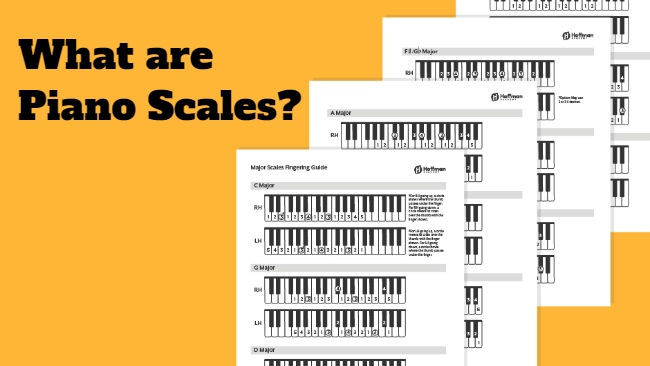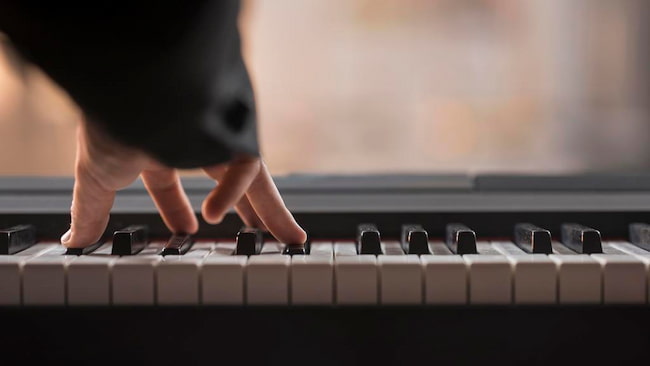Playing the piano is an enjoyable and rewarding experience, but it can be intimidating to learn. One of the most important things you need to understand when learning how to play the piano is the piano scales – what are piano scales and chords, why they’re used, and how to use them.

This guide will cover all aspects of piano scales in detail so that you can gain a better understanding of this fundamental musical concept. We’ll look at different types of piano scales, explain what chords are and how they relate to scales, provide tips on practicing scales effectively, and more. With this comprehensive guide in hand, you’ll soon be able to confidently master playing piano scales.
What are Piano Scales?
Piano scales are a series of notes played in ascending and descending order. They are used as a form of musical language to create melodies, harmonies, chord progressions, and more. Piano scales are the foundation of music theory, as they provide a framework from which musicians can create music. Knowing how to play scales correctly is essential for any aspiring pianist.
Piano scales can be divided into two categories: major scales and minor scales. Major scales are more upbeat and have a bright sound while minor piano scales are more melancholic and have a darker sound. Major and minor scales can be further divided into different modes, such as Dorian or Phrygian. Each mode has its own unique character that musicians can explore when playing piano scales.

If you’re a piano owner, then you must also see this guide on How to clean piano keys ivory. Understanding what chords are and how they relate to scales is also important for developing your piano skills. Chords are formed by taking certain notes from a scale and playing them together at the same time. Different chord progressions can be used to create a variety of musical sounds.
Major Scales
There are 12 major piano scales in total, each with a unique sound and key signature. The most commonly used major scale is the C Major Scale, as it does not contain any sharps or flats. To play the C Major scale, start with your thumb on the middle C and then move up the keyboard one note at a time – C, D, E, F, G, A, B, and then back to C.
Here are the 12 piano major scales with their notes, right-hand and left-hand fingering:
C Major Scale
Notes: C – D – E – F – G – A – B
Fingering (Right Hand): 1-2-3-1-2-3-4-5
Fingering (Left Hand): 5-4-3-2-1-3-2-1
G Major Scale
Notes: G, A, B, C, D, E, F♯, G
Fingering (Right Hand): 1 2 3 – 1 2 3 4 – 5
Fingering (Left Hand): 5 – 4 3 2 1 – 3 2 1
D Major Scale
Notes: D, E, F♯, G, A, B, C♯, D
Fingering (Right Hand): 1 2 3 – 1 2 3 4 – 5
Fingering (Left Hand): 5 – 4 3 2 1 – 3 2 1
A Major Scale
Notes: A, B, C♯, D, E, F♯, G♯, A
Fingering (Right Hand): 1 2 3 – 1 2 3 4 – 5
Fingering (Left Hand): 5 – 4 3 2 1 – 3 2 1
E Major Scale
Notes: E, F♯, G♯, A, B, C♯, D♯, E
Fingering (Right Hand): 1 2 3 – 1 2 3 4 – 5
Fingering (Left Hand): 5 – 4 3 2 1 – 3 2 1
B Major Scale
Notes: B, C♯, D♯, E, F♯, G♯, A♯, B
Fingering (Right Hand): 1 2 3 – 1 2 3 4 – 5
Fingering (Left Hand): 4 3 2 1 – 4 3 2 1
G-flat Major Scale
Notes: G♭, A♭, B♭, C♭, D♭, E♭, F, G♭
Fingering (Right Hand): 2 3 4 – 1 2 3 – 1 2
Fingering (Left Hand): 4 3 2 1 – 3 2 1 – 4
D-flat Major Scale
Notes: D♭, E♭, F, G♭, A♭, B♭, C, D♭
Fingering (Right Hand): 2 3 – 1 2 3 4 – 1 2
Fingering (Left Hand): 3 2 1 – 4 3 2 1 – 4
A-flat Major Scale
Notes: A♭, B♭, C, D♭, E♭, F, G, A♭
Fingering (Right Hand): 3 4 – 1 2 3 -1 2 3
Fingering (Left Hand): 3 2 1 – 4 3 2 1 -3
E-flat Major Scale
Notes: E♭, F, G, A♭, B♭, C, D, E♭
Fingering (Right Hand): 3 – 1 2 3 4 – 1 2 3
Fingering (Right Hand): 3 2 1 – 4 3 2 1 -3
B-flat Major Scale
Notes: B♭, C, D, E♭, F, G, A, B♭
Fingering (Right Hand): 4 – 1 2 3 – 1 2 3 4
Fingering (Right Hand): 3 2 1 – 4 3 2 1 – 3
F Major Scale
Notes: F, G, A, B♭, C, D, E, F
Fingering (Right Hand): 1 2 3 4 -1 2 3 4
Fingering (Right Hand): 5 – 4 3 2 1 – 3 2 1
Minor Scales
There are three forms of minor piano scales: natural minor, harmonic minor, and melodic minor. Natural Minor scales have the same notes as major scales but start on a different note. For example, the C Minor scale is made up of the same notes as the A Major scale but starts on C instead. To play a natural minor scale, start with your thumb on the root note and then move up the keyboard one note at a time – C, D, E♭, F, G, A♭, B♭, and then back to C.
Harmonic minor scales are similar to natural minor scales but contain one additional note – the raised seventh. Melodic minor scales are slightly different, as they have two forms: ascending and descending. When playing an ascending melodic minor scale, the seventh is raised while the sixth remains unchanged. When playing a descending melodic minor scale, both the sixth and seventh notes are lowered.
Here are the 12 minor piano scales with their notes, and right-hand and left-hand fingering:
A Minor Scale
Notes: A, B, C, D, E, F, G, A
Fingering (Right Hand): 1 2 3 – 1 2 3 4 – 5
Fingering (Left Hand): 5 – 4 3 2 1 – 3 2 1
E Minor Scale
Notes: E, F♯, G, A, B, C, D, E
Fingering (Right Hand): 1 2 3 – 1 2 3 4 – 5
Fingering (Left Hand): 5 – 4 3 2 1 – 3 2 1
B Minor Scale
Notes: B, C♯, D, E, F♯, G, A, B
Fingering (Right Hand): 1 2 3 – 1 2 3 4 – 5
Fingering (Left Hand): 4 3 2 1 – 4 3 2 1
F-sharp Minor Scale
Notes: F♯, G♯, A, B, C♯, D, E, F♯
Fingering (Right Hand): 3 4 – 1 2 3 – 1 2 3
Fingering (Left Hand): 4 3 2 1 – 3 2 1 – 4
C-sharp Minor Scale
Notes: C♯, D♯, E, F♯, G♯, A, B, C♯
Fingering (Right Hand): 3 4 – 1 2 3 – 1 2 3
Fingering (Left Hand): 3 2 1 – 4 3 2 1 – 3
G-sharp Minor Scale
Notes: G♯, A♯, B, C♯, D♯, E, F♯, G♯
Fingering (Right Hand): 3 4 – 1 2 3 – 1 2 3
Fingering (Left Hand): 3 2 1 – 4 3 2 1 – 3
F Minor Scale
Notes: F, G, A♭, B♭, C, D♭, E♭, F
Fingering (Right Hand): 1 2 3 4 – 1 2 3 4
Fingering (Left Hand): 5 – 4 3 2 1 – 3 2 1
C Minor Scale
Notes: C, D, E♭, F, G, A♭, B♭, C
Fingering (Right Hand): 1 2 3 – 1 2 3 4 – 5
Fingering (Left Hand): 5 – 4 3 2 1 – 3 2 1
G Minor Scale
Notes: G, A, B♭, C, D, E♭, F, G
Fingering (Right Hand): 1 2 3 – 1 2 3 4 – 5
Fingering (Left Hand): 5 – 4 3 2 1 – 3 2 1
D Minor Scale
Notes: D, E, F, G, A, B♭, C, D
Fingering (Right Hand): 1 2 3 – 1 2 3 4 – 5
Fingering (Left Hand): 5 – 4 3 2 1 – 3 2 1
B-flat Minor Scale
Notes: B♭, C, D♭, E♭, F, G♭, A♭, B♭
RH Fingering: 4- 1 2 3 – 1 2 3 4
LH Fingering: 2 1 – 3 2 1 – 4 3 2
E-flat Minor Scale
Notes: E♭, F, G♭, A♭, B♭, C♭, D♭, E♭
RH Fingering: 3 – 1 2 3 4 – 1 2 3
LH Fingering: 2 1 – 4 3 2 1 – 3 2
Piano Practicing Tips
Now that we’ve covered the basics of what piano scales are, let’s look at some tips on how to practice them.

- Start with one hand at a time: It’s easier to focus and learn how to play scales if you start by playing with just one hand at a time. Once you feel comfortable and have mastered the fingering for each scale, then move on to playing them with both hands together.
- Play slowly: As you practice, make sure to play each scale slowly and accurately. Don’t rush through them and try to memorize the notes as you go.
- Use a metronome: Setting a steady tempo with a metronome will help you remain consistent and stay on track when practicing scales.
- Use recordings: Listening to recordings of piano scales played by a professional pianist can help you understand how the scales should sound when they are played correctly.
- Have fun: Don’t forget to have some fun while practicing! Enjoy experimenting with different tempos and rhythms, or playing scales in various keys.
Final Words
We hope this guide has helped you understand what piano scales are and how to practice them. Remember that mastering scales takes time and patience, so don’t be discouraged if you don’t get it right away. Keep practicing and before long, you’ll be able to play your favorite scales with ease! Good luck! For more information, visit Pianoshub. Thanks for reading.